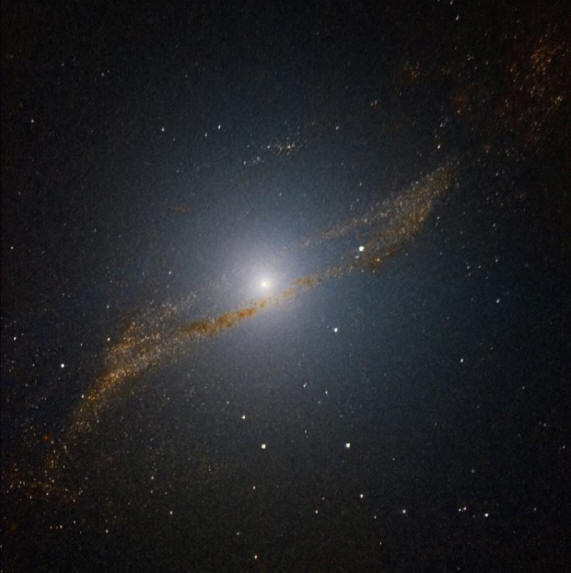A Twist in the Ring of Centaurus
A
Dec
02, 2009
A new infrared image of the
Centaurus A galaxy reveals a ring of
stars inside the visually obscuring
dust around its core. Astronomers
assume the ring is the remnant of a
smaller galaxy that merged with the
larger one.
The
press release reports: “What the
astronomers found was surprising:
‘There is a clear ring of stars and
clusters hidden behind the dust
lanes…,’ says Jouni Kainulainen,
lead author of the paper reporting
these results. ‘Further analysis of
this structure will provide
important clues on how the merging
process occurred….’”
Providing, of course, that the
familiar assumptions of the past
apply to this very unfamiliar
object. How quickly we forget: Half
a century ago, radio astronomy was
developing in Australia because
American astronomers, sure that it
would be a waste of time and
resources, would not allow such
activities. Their familiar
assumptions ruled out anything in
space that would generate radio
waves.
Next came x-ray astronomy with
another “what the astronomers found
was surprising.” After that came
infrared astronomy and press
releases such as this one. Surprise,
followed by reasserting familiar
assumptions, has been the one
constant activity of astronomers.
“Merging” is now the fashionable
round conceptual hole into which
square pegs of data are pounded.
A cursory familiarity with the
fundamentals of plasma cosmology
immediately suggests an entirely
unsurprising, in fact expected,
explanation. Active galaxies
especially—and Centaurus A (CenA) is
indeed active—display the
characteristic axial jets and
transverse toroid of unstable plasma
discharges.
At the center of CenA is a thread of
radio and x-ray emission, running
roughly perpendicular to the ring of
stars in the image, with knots of
brighter luminosity in it. Farther
away are knotty filaments, rotated a
bit toward the north. In deep
images, a spike of low luminosity
extends beyond the filaments. Radio
maps record strong lobes of radio
emission that flare far from the
galaxy to north and south.
Furthermore, a dozen active galaxies
stretch along the same line thru
CenA for over twenty degrees. These
include radio and X-ray galaxies,
Seyfert, spiral, elliptical, and
peculiar galaxies, with redshifts
ranging from .005 to .130.
Additionally, “the bright Abell
clusters of galaxies in this large
region of the sky [a 40-by-40-degree
survey area] are distributed in the
same characteristic way as the
bright and active galaxies that
belong to CenA!”
The redshifts of these Abell
clusters occur in two ranges: “six
with .011<z<.017 and seven with
.035<z<.055…. Redshift
discretization is typical of
galaxies with intrinsic redshifts.”
[Halton Arp, Seeing Red, p. 147-8]
Having delineated the axial jet,
swept into a spiral in this case by
the presumed eighth-turn rotation of
CenA during its ejection activity,
we can now identify the ring of
stars in the ESO image with a
discharge toroid.
Laboratory high-energy discharges
generate toroid, or ring, currents
around the axis of the discharge.
The toroids flatten and, as the
current increases, warp and curl at
their edges. “The edges curl in and
out and upwards and downwards to the
current flow.” [Anthony L. Peratt,
“Characteristics for the Occurrence
of a High-Current, Z-Pinch Aurora as
Recorded in Antiquity”, IEEE
Transactions on Plasma Science, Vol.
31, No. 6, December 2003, pp.
1195-6.]
The stars in the ring inside CenA
have been pinched out of just such a
toroidal current. The twists up and
down at the far edges indicate an
advanced stage of discharging. This
conclusion is supported by the
spiral line of ejections and the
fact that the oldest objects have
already
evolved
from the “knot” phase,
through the “Abell cluster” phase,
and into the “companion galaxy”
phase.
Mel Acheson
|
SPECIAL NOTE - **New Volumes Available:
We are pleased to announce a new
e-book series
THE UNIVERSE ELECTRIC. Available now, the first volume
of this series, titled Big Bang, summarizes the failure of modern cosmology
and offers a new electrical perspective on the cosmos. At
over 200 pages, and
designed for broadest public appeal, it combines spectacular
full-color graphics with lean and readily understandable
text.
**Then second and third volumes in the series are now available,
respectively titled Sun and Comet, they offer
the reader easy to understand explanations of how and why these bodies
exist within an Electric Universe.
High school and college students--and teachers in
numerous fields--will love these books. So will a large
audience of general readers.
Visitors to the Thunderbolts.info site have often
wondered whether they could fully appreciate the Electric
Universe without further formal education. The answer is
given by these exquisitely designed books. Readers from
virtually all backgrounds and education levels will find them
easy to comprehend, from start to finish.
For the Thunderbolts Project, this series is a milestone.
Please see for yourself by checking out the new
Thunderbolts Project website, our leading edge in
reaching new markets globally.
Please visit our
Forum
|
|







